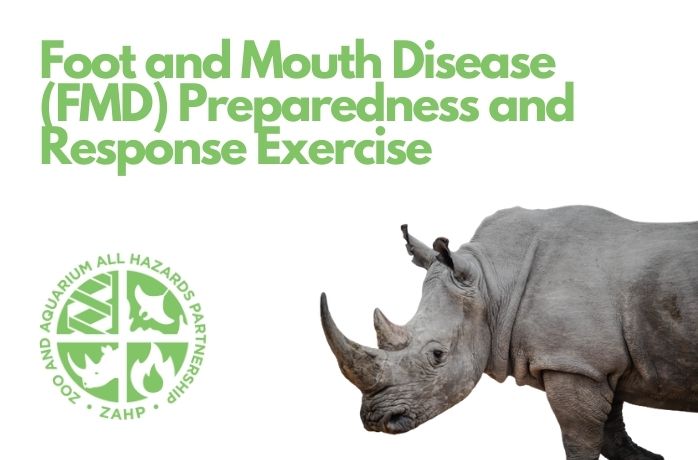ZAHP is excited to announce the Foot and Mouth Disease (FMD) Preparedness and Response Exercise, created in collaboration with 4th-year DVM/MPH students Myra Brooks, Corrin Markey, and Corwin Martin of Virginia-Maryland College of Veterinary Medicine.
In 2020, ZAHP partnered with three veterinary students at Virginia-Maryland College of Veterinary Medicine (VMCVM) to assist them in fulfilling requirements for their Masters of Public Health Integrative Learning Experience. ZAHP served as an External Stakeholder Mentor, and helped the students to select and complete a project that benefitted the stakeholders – the exotic animal industry.
Based on the interests of the students and the needs of the exotic animal industry, ZAHP and the students decided to develop a tabletop exercise to test Foot and Mouth disease (FMD) preparedness plans in a “no-fault” exercise environment.
This tabletop exercise was developed to assess preparedness for FMD in a zoological facility. The scenario begins with the FMD outbreak already underway and confirmed cases in the facility petting zoo, allowing players to consider necessary actions during an active outbreak.
The objectives of this exercise are to help participants:
- Understand the Federal, State, Local and Zoological stakeholders involved in a response to Foot and Mouth Disease
- Understand the management of communication and coordination that would occur during an FMD outbreak
- Display basic knowledge of organized outbreak response to an infectious disease
- Explore options for vaccination of high-value zoological species
Students used the Homeland Security Exercise Evaluation Plan (HSEEP) to develop this exercise. At the suggestion of ZAHP’s Dr. Yvonne Nadler, who has participated in several national and state-level HSEEP FMD exercises where zoos and wild animal parks were seldom included in discussions, students decided to develop an exercise that would specifically focus on zoological challenges when responding to FMD. You can learn more about HSEEP here.
HSEEP exercise development provides templates to help standardize how a scenario is presented to players. Most importantly, HSEEP determines defined objectives of the exercise, and encourages recording both successes during the exercise and areas for improvement for the next planning event.
It should be noted that, given the time frame for this project, not all of the recommended documents for an HSEEP exercise were developed. Of greatest value to the exotic animal community, even for the sake of reviewing current plans, is the Situation Manual. It clearly states the exercise objectives, identifies the important participants for the exercise, outlines the structure, and presents the scenario of an outbreak in a fictitious zoo.
A series of questions are presented to the players, and the discussion that ensues is captured in the Exercise Evaluation Guides (EEGs) that were also developed for this project. The EEGs list which “critical tasks” the facility would need to carry out in an outbreak, and by recording all discussion during the exercise, players will be able to review which critical tasks were or were not addressed. In that way, if a task is NOT mentioned during play, it’s an opportunity to update current plans in the event of a real outbreak situation.
Exercises are most effective when actually “played” to test plans. However, even by reviewing the Situation Manual and EEGs, a facility can get a better idea of how fast a Foreign Animal Disease investigation will be managed, all the stakeholders that will be involved, and highlight the elements that could be added to their plans to increase resiliency to FMD.
Exercise materials are provided below and may be used by facilities to test and evaluate plans:

